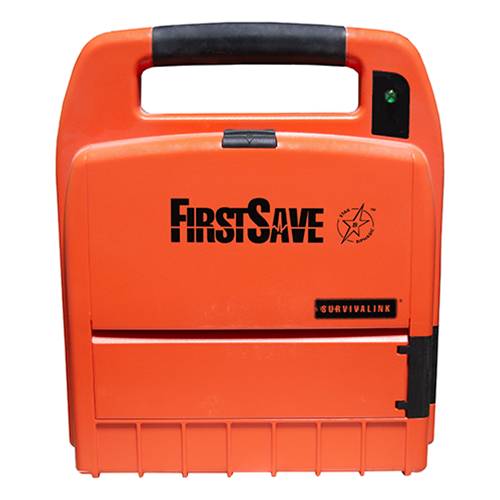Cardiac Science Survivalink Features
The Cardiac Science Survivalink is a self-testing battery-operated automated external defibrillator (AED). After applying the Survivalink AED’s electrodes to the patient’s chest, the Survivalink AED automatically analyzes the patient’s Electrocardiogram (ECG). The survivalink AED advises you to deliver a defibrillation shock upon analyzing a shockable-cardiac rhythm.
- One button for all operations.
- Guides you through the rescue with voice prompts audible alerts, and visual indicators.
- Shocks are delivered in a pre-programmed sequence of escalating monophasic, or biphasic energies.
Cardiac Science Survivalink Specifications
Dimensions
- Height: 3.3” (8 cm)
- Width: 10.6” (27 cm)
- Depth: 12.4” (31 cm)
- Weight: 7.4 to 7.8 lbs (3.3 to 3.5 kg)
Interpretation of ECG
The Survivalink AED Rhythm Recognition Detection System is designed to recommend a defibrillation shock when placed on a patient who is unconscious, not breathing, and has no pulse, when it detects:
- Ventricular fibrillation: when peak to peak amplitude is greater than asystole threshold (0.15 mV nominal) and cardiac rhythm rate of at least 180 bpm
- Ventricular tachycardia: cardiac rhythm rate is at least 180 bpm
- Supraventricular tachycardia: cardiac rhythm rate is at least 180 bpm
Battery
- Type: Extended Life Lithium, disposable, non-rechargeable
- Operating Life: 5-years
- Shelf Life: 5-years
- Charge Time: 11 seconds to charge a fully discharged Survivalink AED to its maximum energy with a new battery.
Energy Levels
- The Survivalink AED utilizes variable energy. The precise energy delivered will vary with the patient’s impedance. Energy will be delivered at two different levels referred to as low current and high current. This allows for escalating energies of subsequent shocks.

